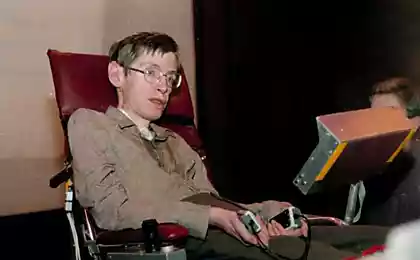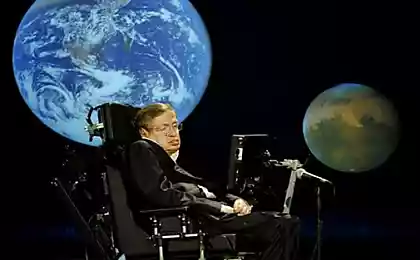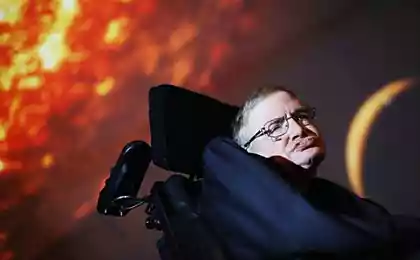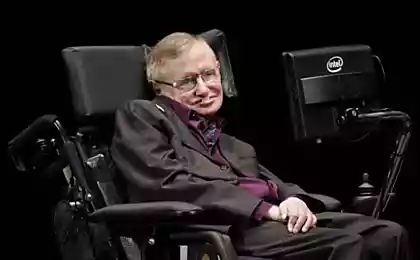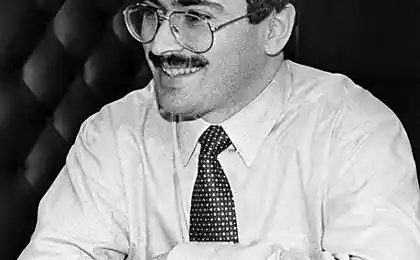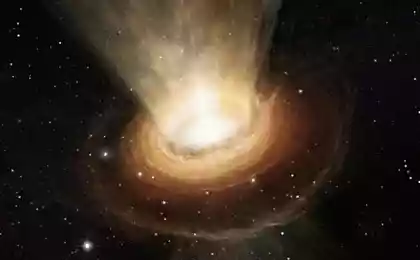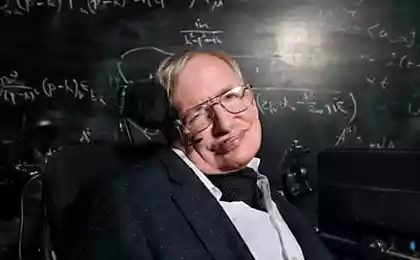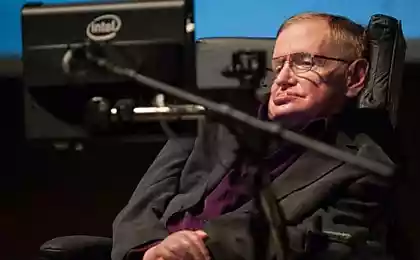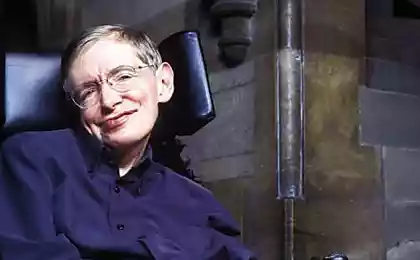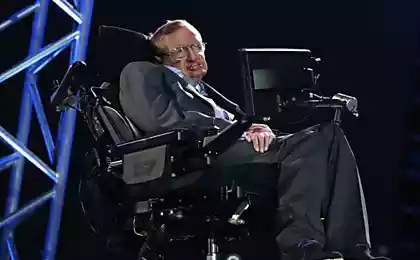708
Stephen Hawking on black holes and the villains of James bond
Thirty eight million nine hundred fifty nine thousand seventy six
Wired magazine spoke with Stephen Hawking — renowned astrophysicist and expert in black holes, confined to a wheelchair due to amyotrophic lateral sclerosis. We offer you a translation of an interesting text in which Stephen Hawking, perhaps covered with parties previously unknown to you.
In the afternoon of 23 September 2014, for a few minutes before the start of lectures in Los Pueblos in Tenerife, Stephen William Hawking was rewriting parts of his speech. Hawking is known that deals with theoretical physics and fundamental problems in physics (his last powerful work, published in January 2014, called "information Preservation and weather forecasting for black holes"), very famous and very slow writes.
He operates his computer by moving his right cheek muscle. Her movements are captured using an infrared sensor connected to the points that allows the scientist to move a cursor on a computer screen connected to a wheelchair. He painstakingly builds sentences at a rate of several words per minute, this speed gradually decreases as the deterioration of his muscle control. In this condition it has got amyotrophic lateral sclerosis, a disease of the neurons from which he was suffering from the age of 21 (he took part in the ALS Ice Bucket Challenge in August at the expense of their children: "Since I had pneumonia last year, it would be foolish to pour me a bucket of cold water"). His lecture in Tenerife was called the "Quantum birth of the Universe". The audience of 1,500 seats was filled completely.
"He copied the text at the last minute, so we were a bit panicked, says Jonathan wood, Hawking's assistant. His responsibilities included everything from technical assistance to managing social media. — He always does. I make slides in PowerPoint because he can't. I'm not a physicist, and he often talks about things that I don't understand why he has to constantly explain what slides he wants".
This lecture was part of the sixth "Starmus" (Starmus), a six-day science festival that gathered a group of outstanding scientists, including Nobel laureate John Mather, biologist Richard Dawkins and Queen guitarist Brian may, an expert in astronomy of three dimensions. But the main star was Hawking.
When he got on stage to help him surrounded by nurses and assistants, a giant screen showed a montage on the topic of collisions of black holes and frames taken from the viewpoint of Hawking, sitting in a wheelchair.
Hawking always starts his lectures the same way — with the words: "can you hear me?". Hawking knows how to be expressive and hilarious at the same time to guide the audience through bold ideas about the origin of the Universe, developed over the past decades. Actually, for this blend of humor and complicated theoretical physics and like Hawking, who is 72 years old and who has already become a kind of symbol of the scientist. His portraits adorn their jobs, he wanted to be photographed Barack Obama, bill Clinton and Steven Spielberg (twice), he appeared in "Star trek" and "the simpsons."
"I attended his famous lecture "In the field of view is observed the end of theoretical physics?", says physicist Neil Turok, an old friend and colleague of Hawking. — The lecture proceeded in a funny way, as a series of anecdotes. He was bold and naive, said he thinks that in 20 years it will curdle. Twenty years later he held another lecture, titled "is it finally the end of theoretical physics in sight?" and admitted that he would have to wait another twenty years".
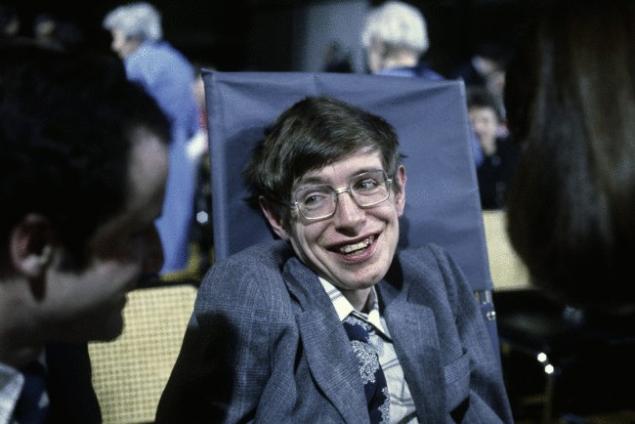
Stephen Hawking on October 10, 1979, Princeton, new Jersey
Hawking manages to create its image, combining the popular appeal of Carl Sagan with a gorgeous understanding of theoretical physics Richard Feynman. He deftly packs his theories and thoughts (it is known that it can reflect deeply about physics even when visiting social events) in popular books, from "a Brief history of time" — the bestseller that almost independently re-launched the era of popular science literature — to the "Grand design", co-authored with physicist Leonard Mlodinow in 2010. These books more than anything else demonstrate the propensity of Hawking to a concise and bold statements with a mixture of unconventional humor. Here, for example, pondering over the idea of the multiverse, Hawking admitted that the Universe may not be unique stories, but rather a collection of all possible histories of the Universe, equally real and with its own set of physical laws.
"Can be one story, in which the Moon consists of Roquefort cheese, writes Hawking. But we can see that the Moon is not made of cheese, and that's bad news for mice."
The social role of Hawking does not detract from the fact that over the past five decades, he became one of the most daring space explorers, at least, mentally — his mind wanders in theoretical dimensions that, for the most part remain inaccessible to experiment and direct observation. Out of necessity (he can no longer write equations) Hawking has developed an original method of thinking about the mysteries of the cosmos, relying not so much on the equation, like most physicists, preferring to think in terms of images and geometry. These tools are the best allies for those who want to achieve powerful, intuitive breakthroughs, rather than make incremental improvements in our understanding of the cosmos.
"He opened a new field of physics, says Kip Thorne, a physicist at Caltech and one of the world's leading experts in the field of General relativity. The works of Kip Thorne and his direct help Christopher Nolan directed the film "interstellar". — There were several key moments in his career, when he made a huge breakthrough, and everyone else trying to catch up or understand it with all your strength".
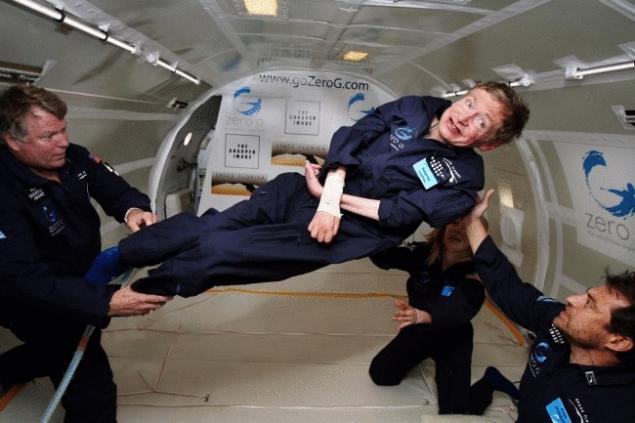
Stephen Hawking in zero gravity, April 26, 2007
The manner in which he went from breakthrough to breakthrough, particularly in the most productive period of 70-80 years, was very unusual, as Hawking not only regularly demonstrated a far-reaching views, but was prone to abrupt transitions and reversals. He first proved that the universe began with a singularity — event in space-time in which all the laws of physics are broken to pieces — and then working with James Hartley, developed a proposal "infinity", assuming that before the Big Bang time did not exist, and therefore, the universe had no beginning.
"There is no sense to talk about time before the universe. It's like looking for a point South of the South Pole".
He was also one of the first physicists who developed the code of laws for the dynamics of black holes, including the fact that black holes can never decrease; he later discovered that they can definitely decrease — they evaporate due to radiation (known today as Hawking radiation). This conclusion was very controversial, and generated discussion for decades and has formed the basis of several important books.
WIRED met Stephen Hawking the day after the lecture. His nurse, Patricia dowdy was holding his hand to help him to carry out a slight handshake. Jeanna York, his personal assistant, introduced Hawking. His team has developed a way to communicate with him, asking only those questions that can be answered with "Yes" or "no", and carefully watching his facial expressions, interpreting thoughts and feelings. Hawking arrived in Tenerife on the water (the doctor has forbidden to fly because of health), the journey took six days.
He was in a good mood, often smiling, as if challenging the stillness of his body. Stillness is probably the condition which Hawking is most familiar, but it never stopped him from the constant movement, both physical and mental. Unstoppable perseverance, perhaps, characterizes Hawking best. "I'm just a kid that never grew up" — he wrote in his autobiography. "I continue to ask the questions "how" and "why". Sometimes you find the answers."
Wired: What lessons in cosmology, in your opinion, the readers of Wired must learn if you want to keep up with current thinking?
Stephen Hawking: They need to understand that the universe began with a period of inflation, which expanded with incredible speed. Quantum fluctuations led to the fact that some regions were expanding more slowly the rest of the Universe. These regions eventually stopped expanding and collapsed, forming stars and galaxies and all the structures in the universe. Quantum fluctuations during inflation also create a primary gravitational waves.
Wired: the Mathematician Roger Penrose has mentioned that you always ask awkward questions. The question you ask right now?
Hawking: I'm working on how to reconcile the apparent loss of information during the evaporation of a black hole with our understanding of physics, information is never lost. I raised this issue 40 years ago and, despite the large number of works has not received a satisfactory solution to this paradox. Instead, he revealed the contradiction between the fact that the information is not lost, and the usual assumption that physics is local. Also suggested that somewhere outside the black hole there is a wall of fire (firewall), which just burns everything that it hits, but I don't believe in firewalls. I rather think that space-time is curved.
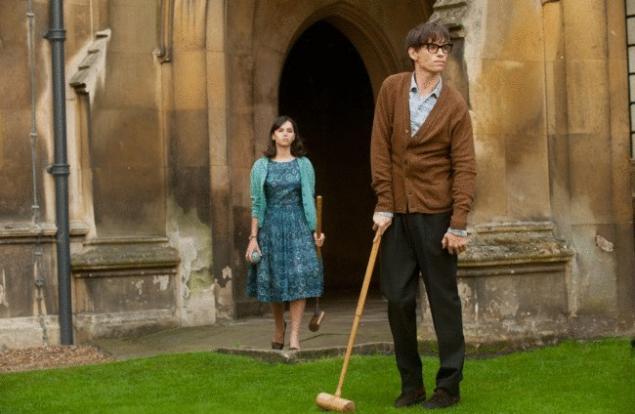
A scene from the movie "the Theory of everything"
Wired: You also believe that the Universe has no single past but various possible stories. What experiments could confirm this theory?
Hawking: Feynman's Idea about the amount of stories is that each system develops a historical way. This can be demonstrated by directing the particle beam onto a sheet with two slits. The number of particles falling on the screen behind the slits, forms a band, as if they were light rays. The interpretation is that each particle has two alternative stories, one through one slit, the other through the other, and they intersect, interfere like rays of light.
Wired: In his book "the Grand design", you write that M-theory is a theory that I wanted to find Einstein predicting and describing the Universe, and that physics came to her abstract considerations of logic. However, this theory has not been confirmed experimentally. If experimental physics was not restricted to existing technology and financial budgets, what predictions your theories you would like to test empirically? And if you could come up with an experiment without such constraints, what would it be?
Hawking: I'm starting to doubt M-theory, but viable alternatives seem to have gone. M-theory suggests that supersymmetry is a symmetry between particles of matter, like a photon, like an electron. Supersymmetry would mean that all particles known to us, have superpartners, but so far none found. As for the experiment, I would like to detect Hawking radiation the black hole, because then I would win the Nobel prize.
Hawking radiation is extremely difficult to detect, because the radiation of a black hole with a mass of a few suns is the temperature of just one millionth of a degree above absolute zero. Small primary black holes would have a higher temperature, but there seems to be close to there.
Wired: Your old friend, physicist Kip Thorne, has described that when you lost the ability to use your hands, you developed a powerful set of tools that no one, including the unusual ability to manipulate mental images of objects, curves, surfaces, shapes, in three and in four dimensions of space and time. Can you describe this thought process? Don't you think that solve problem which can't solve the others, because this particular set of mental tools?
Hawking: no One can imagine four dimensions. Three is already difficult. I visualize two-dimensional cross-section, remembering that they are part of a four-dimensional whole. This geometric visualization I used in the proof of the theorem of singularity in my own work on black holes, including the radiation of a black hole. My disability does not allow you to write complex equations, so I prefer to work with a geometric interpretation.
Wired: You said that there is nothing better than a moment of "Eureka" — discovery of something new. Can you describe your favorite moment of "Eureka"?
Hawking: I went to bed after the birth of my daughter Lucy. My disability has severely slowed the process, so I had time to think about black holes. Suddenly I realized that if two black holes collide and merge, the area of the horizon of the final black hole will be greater than the sum of the areas of the original black holes. I was so excited I couldn't sleep that night.
Wired: In your life was the moment you lost the ability to speak, and therefore communicate. Later you wrote "a Brief history of time", which has fundamentally changed scientific publishing market and opened the way for popular science books. Where did the desire to communicate in a scientific field?
Hawking: I could speak with a speech synthesizer, though it gave me an American accent. I have kept that voice, because it's now my trademark. Before I lost my voice, it was so slurred that only close to me to understand, but with the computer voice, I found I could give popular lectures. I like to communicate in the scientific circle. It is very important that the public understand the scientific basis, otherwise the vital decisions be made by others.
Wired: You've been defending a point of view on the topic of what we need to colonize other worlds. How can humanity achieve this?
Hawking: I believe that the human race cannot survive on Earth indefinitely without some catastrophe. But I would like us to spread in space and did not keep all the eggs in one basket, or on one planet.
Wired: Can you tell us more about the work being done together with Intel and which is devoted to the techniques of increasing the speed of your communication, like text prediction engines, brain-computer interfaces, face recognition and other sensors?
Hawking: Intel has created a text editor for me based on predictive text, which allows me to write faster. The program is activated by a small sensor on my glasses. I write these responses. Intel is going to open the source code of the program to make it available to other people. Intel also tried to work on face recognition, but the range of messages that I can convey is very limited. With brain-computer interfaces I also have not had much success. My teachers say it's because I have no brain waves.
Wired: You were in "the simpsons" took part in a documentary film by Errol Morris, you was produced by Steven Spielberg, you hit "Star trek". What would be your ideal movie role? How do you feel about modern pop culture?
Hawking: My ideal role — the villain in the film about James bond. I think the wheelchair and the computer voice would fit perfectly. I know very little about popular culture, because spending all the time in science.
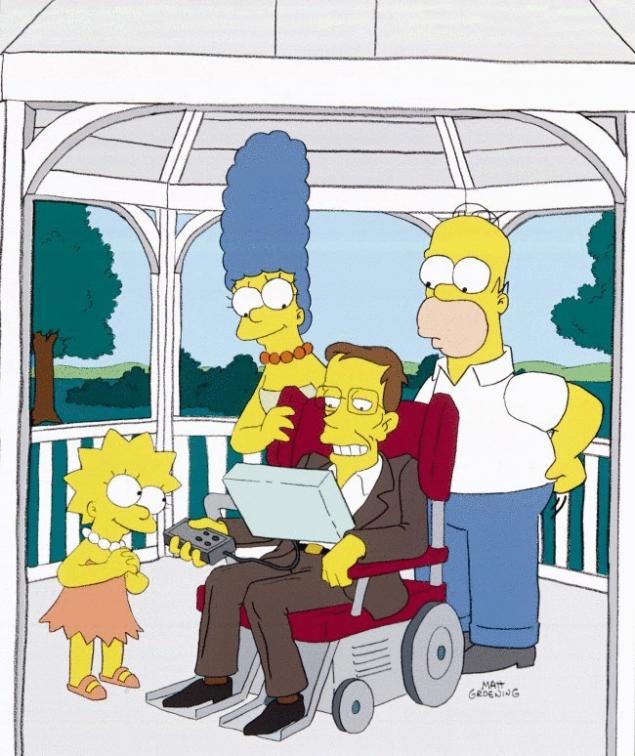
Source: hi-news.ru
Wired magazine spoke with Stephen Hawking — renowned astrophysicist and expert in black holes, confined to a wheelchair due to amyotrophic lateral sclerosis. We offer you a translation of an interesting text in which Stephen Hawking, perhaps covered with parties previously unknown to you.
In the afternoon of 23 September 2014, for a few minutes before the start of lectures in Los Pueblos in Tenerife, Stephen William Hawking was rewriting parts of his speech. Hawking is known that deals with theoretical physics and fundamental problems in physics (his last powerful work, published in January 2014, called "information Preservation and weather forecasting for black holes"), very famous and very slow writes.
He operates his computer by moving his right cheek muscle. Her movements are captured using an infrared sensor connected to the points that allows the scientist to move a cursor on a computer screen connected to a wheelchair. He painstakingly builds sentences at a rate of several words per minute, this speed gradually decreases as the deterioration of his muscle control. In this condition it has got amyotrophic lateral sclerosis, a disease of the neurons from which he was suffering from the age of 21 (he took part in the ALS Ice Bucket Challenge in August at the expense of their children: "Since I had pneumonia last year, it would be foolish to pour me a bucket of cold water"). His lecture in Tenerife was called the "Quantum birth of the Universe". The audience of 1,500 seats was filled completely.
"He copied the text at the last minute, so we were a bit panicked, says Jonathan wood, Hawking's assistant. His responsibilities included everything from technical assistance to managing social media. — He always does. I make slides in PowerPoint because he can't. I'm not a physicist, and he often talks about things that I don't understand why he has to constantly explain what slides he wants".
This lecture was part of the sixth "Starmus" (Starmus), a six-day science festival that gathered a group of outstanding scientists, including Nobel laureate John Mather, biologist Richard Dawkins and Queen guitarist Brian may, an expert in astronomy of three dimensions. But the main star was Hawking.
When he got on stage to help him surrounded by nurses and assistants, a giant screen showed a montage on the topic of collisions of black holes and frames taken from the viewpoint of Hawking, sitting in a wheelchair.
Hawking always starts his lectures the same way — with the words: "can you hear me?". Hawking knows how to be expressive and hilarious at the same time to guide the audience through bold ideas about the origin of the Universe, developed over the past decades. Actually, for this blend of humor and complicated theoretical physics and like Hawking, who is 72 years old and who has already become a kind of symbol of the scientist. His portraits adorn their jobs, he wanted to be photographed Barack Obama, bill Clinton and Steven Spielberg (twice), he appeared in "Star trek" and "the simpsons."
"I attended his famous lecture "In the field of view is observed the end of theoretical physics?", says physicist Neil Turok, an old friend and colleague of Hawking. — The lecture proceeded in a funny way, as a series of anecdotes. He was bold and naive, said he thinks that in 20 years it will curdle. Twenty years later he held another lecture, titled "is it finally the end of theoretical physics in sight?" and admitted that he would have to wait another twenty years".

Stephen Hawking on October 10, 1979, Princeton, new Jersey
Hawking manages to create its image, combining the popular appeal of Carl Sagan with a gorgeous understanding of theoretical physics Richard Feynman. He deftly packs his theories and thoughts (it is known that it can reflect deeply about physics even when visiting social events) in popular books, from "a Brief history of time" — the bestseller that almost independently re-launched the era of popular science literature — to the "Grand design", co-authored with physicist Leonard Mlodinow in 2010. These books more than anything else demonstrate the propensity of Hawking to a concise and bold statements with a mixture of unconventional humor. Here, for example, pondering over the idea of the multiverse, Hawking admitted that the Universe may not be unique stories, but rather a collection of all possible histories of the Universe, equally real and with its own set of physical laws.
"Can be one story, in which the Moon consists of Roquefort cheese, writes Hawking. But we can see that the Moon is not made of cheese, and that's bad news for mice."
The social role of Hawking does not detract from the fact that over the past five decades, he became one of the most daring space explorers, at least, mentally — his mind wanders in theoretical dimensions that, for the most part remain inaccessible to experiment and direct observation. Out of necessity (he can no longer write equations) Hawking has developed an original method of thinking about the mysteries of the cosmos, relying not so much on the equation, like most physicists, preferring to think in terms of images and geometry. These tools are the best allies for those who want to achieve powerful, intuitive breakthroughs, rather than make incremental improvements in our understanding of the cosmos.
"He opened a new field of physics, says Kip Thorne, a physicist at Caltech and one of the world's leading experts in the field of General relativity. The works of Kip Thorne and his direct help Christopher Nolan directed the film "interstellar". — There were several key moments in his career, when he made a huge breakthrough, and everyone else trying to catch up or understand it with all your strength".

Stephen Hawking in zero gravity, April 26, 2007
The manner in which he went from breakthrough to breakthrough, particularly in the most productive period of 70-80 years, was very unusual, as Hawking not only regularly demonstrated a far-reaching views, but was prone to abrupt transitions and reversals. He first proved that the universe began with a singularity — event in space-time in which all the laws of physics are broken to pieces — and then working with James Hartley, developed a proposal "infinity", assuming that before the Big Bang time did not exist, and therefore, the universe had no beginning.
"There is no sense to talk about time before the universe. It's like looking for a point South of the South Pole".
He was also one of the first physicists who developed the code of laws for the dynamics of black holes, including the fact that black holes can never decrease; he later discovered that they can definitely decrease — they evaporate due to radiation (known today as Hawking radiation). This conclusion was very controversial, and generated discussion for decades and has formed the basis of several important books.
WIRED met Stephen Hawking the day after the lecture. His nurse, Patricia dowdy was holding his hand to help him to carry out a slight handshake. Jeanna York, his personal assistant, introduced Hawking. His team has developed a way to communicate with him, asking only those questions that can be answered with "Yes" or "no", and carefully watching his facial expressions, interpreting thoughts and feelings. Hawking arrived in Tenerife on the water (the doctor has forbidden to fly because of health), the journey took six days.
He was in a good mood, often smiling, as if challenging the stillness of his body. Stillness is probably the condition which Hawking is most familiar, but it never stopped him from the constant movement, both physical and mental. Unstoppable perseverance, perhaps, characterizes Hawking best. "I'm just a kid that never grew up" — he wrote in his autobiography. "I continue to ask the questions "how" and "why". Sometimes you find the answers."
Wired: What lessons in cosmology, in your opinion, the readers of Wired must learn if you want to keep up with current thinking?
Stephen Hawking: They need to understand that the universe began with a period of inflation, which expanded with incredible speed. Quantum fluctuations led to the fact that some regions were expanding more slowly the rest of the Universe. These regions eventually stopped expanding and collapsed, forming stars and galaxies and all the structures in the universe. Quantum fluctuations during inflation also create a primary gravitational waves.
Wired: the Mathematician Roger Penrose has mentioned that you always ask awkward questions. The question you ask right now?
Hawking: I'm working on how to reconcile the apparent loss of information during the evaporation of a black hole with our understanding of physics, information is never lost. I raised this issue 40 years ago and, despite the large number of works has not received a satisfactory solution to this paradox. Instead, he revealed the contradiction between the fact that the information is not lost, and the usual assumption that physics is local. Also suggested that somewhere outside the black hole there is a wall of fire (firewall), which just burns everything that it hits, but I don't believe in firewalls. I rather think that space-time is curved.

A scene from the movie "the Theory of everything"
Wired: You also believe that the Universe has no single past but various possible stories. What experiments could confirm this theory?
Hawking: Feynman's Idea about the amount of stories is that each system develops a historical way. This can be demonstrated by directing the particle beam onto a sheet with two slits. The number of particles falling on the screen behind the slits, forms a band, as if they were light rays. The interpretation is that each particle has two alternative stories, one through one slit, the other through the other, and they intersect, interfere like rays of light.
Wired: In his book "the Grand design", you write that M-theory is a theory that I wanted to find Einstein predicting and describing the Universe, and that physics came to her abstract considerations of logic. However, this theory has not been confirmed experimentally. If experimental physics was not restricted to existing technology and financial budgets, what predictions your theories you would like to test empirically? And if you could come up with an experiment without such constraints, what would it be?
Hawking: I'm starting to doubt M-theory, but viable alternatives seem to have gone. M-theory suggests that supersymmetry is a symmetry between particles of matter, like a photon, like an electron. Supersymmetry would mean that all particles known to us, have superpartners, but so far none found. As for the experiment, I would like to detect Hawking radiation the black hole, because then I would win the Nobel prize.
Hawking radiation is extremely difficult to detect, because the radiation of a black hole with a mass of a few suns is the temperature of just one millionth of a degree above absolute zero. Small primary black holes would have a higher temperature, but there seems to be close to there.
Wired: Your old friend, physicist Kip Thorne, has described that when you lost the ability to use your hands, you developed a powerful set of tools that no one, including the unusual ability to manipulate mental images of objects, curves, surfaces, shapes, in three and in four dimensions of space and time. Can you describe this thought process? Don't you think that solve problem which can't solve the others, because this particular set of mental tools?
Hawking: no One can imagine four dimensions. Three is already difficult. I visualize two-dimensional cross-section, remembering that they are part of a four-dimensional whole. This geometric visualization I used in the proof of the theorem of singularity in my own work on black holes, including the radiation of a black hole. My disability does not allow you to write complex equations, so I prefer to work with a geometric interpretation.
Wired: You said that there is nothing better than a moment of "Eureka" — discovery of something new. Can you describe your favorite moment of "Eureka"?
Hawking: I went to bed after the birth of my daughter Lucy. My disability has severely slowed the process, so I had time to think about black holes. Suddenly I realized that if two black holes collide and merge, the area of the horizon of the final black hole will be greater than the sum of the areas of the original black holes. I was so excited I couldn't sleep that night.
Wired: In your life was the moment you lost the ability to speak, and therefore communicate. Later you wrote "a Brief history of time", which has fundamentally changed scientific publishing market and opened the way for popular science books. Where did the desire to communicate in a scientific field?
Hawking: I could speak with a speech synthesizer, though it gave me an American accent. I have kept that voice, because it's now my trademark. Before I lost my voice, it was so slurred that only close to me to understand, but with the computer voice, I found I could give popular lectures. I like to communicate in the scientific circle. It is very important that the public understand the scientific basis, otherwise the vital decisions be made by others.
Wired: You've been defending a point of view on the topic of what we need to colonize other worlds. How can humanity achieve this?
Hawking: I believe that the human race cannot survive on Earth indefinitely without some catastrophe. But I would like us to spread in space and did not keep all the eggs in one basket, or on one planet.
Wired: Can you tell us more about the work being done together with Intel and which is devoted to the techniques of increasing the speed of your communication, like text prediction engines, brain-computer interfaces, face recognition and other sensors?
Hawking: Intel has created a text editor for me based on predictive text, which allows me to write faster. The program is activated by a small sensor on my glasses. I write these responses. Intel is going to open the source code of the program to make it available to other people. Intel also tried to work on face recognition, but the range of messages that I can convey is very limited. With brain-computer interfaces I also have not had much success. My teachers say it's because I have no brain waves.
Wired: You were in "the simpsons" took part in a documentary film by Errol Morris, you was produced by Steven Spielberg, you hit "Star trek". What would be your ideal movie role? How do you feel about modern pop culture?
Hawking: My ideal role — the villain in the film about James bond. I think the wheelchair and the computer voice would fit perfectly. I know very little about popular culture, because spending all the time in science.

Source: hi-news.ru

